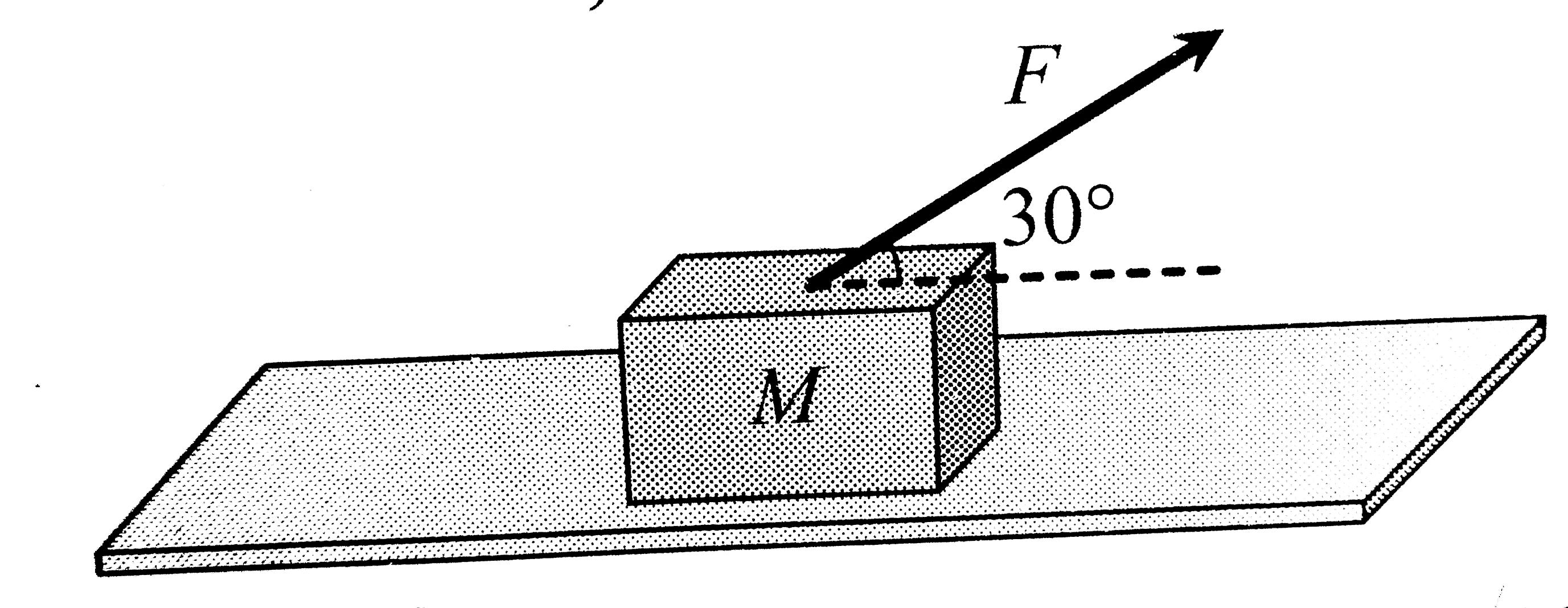A block of mass 10kg is placed on a rough horizontal surface having coefficient of friction μ=0.5 . If a horizontal force of 100N is acting on it, then acceleration of the block will be.
10ms−2
5ms−2
15ms−2
0.5ms−2
The correct Answer is:B
To solve the problem step by step, we can follow these calculations:
Step 1: Identify the given values
- Mass of the block (m) = 10 kg
- Coefficient of friction (μ) = 0.5
- Applied horizontal force (F) = 100 N
- Acceleration due to gravity (g) = 10 m/s² (assuming standard value)
Step 2: Calculate the normal force (N)
The normal force acting on the block is equal to the weight of the block, which can be calculated using the formula:
N=m⋅g
Substituting the values:
N=10kg⋅10m/s2=100N
Step 3: Calculate the maximum frictional force (f)
The maximum frictional force can be calculated using the formula:
fmax=μ⋅N
Substituting the values:
fmax=0.5⋅100N=50N
Step 4: Determine the net force acting on the block
The net force (F_net) acting on the block can be found by subtracting the frictional force from the applied force:
Fnet=F−fmax
Substituting the values:
Fnet=100N−50N=50N
Step 5: Calculate the acceleration (a) of the block
Using Newton's second law, the acceleration can be calculated as:
Fnet=m⋅a
Rearranging the formula gives:
a=Fnetm
Substituting the values:
a=50N10kg=5m/s2
Final Answer
The acceleration of the block is 5m/s2.
---
- Mass of the block (m) = 10 kg
- Coefficient of friction (μ) = 0.5
- Applied horizontal force (F) = 100 N
- Acceleration due to gravity (g) = 10 m/s² (assuming standard value)
The normal force acting on the block is equal to the weight of the block, which can be calculated using the formula:
N=m⋅g
Substituting the values:
N=10kg⋅10m/s2=100N
The maximum frictional force can be calculated using the formula:
fmax=μ⋅N
Substituting the values:
fmax=0.5⋅100N=50N
The net force (F_net) acting on the block can be found by subtracting the frictional force from the applied force:
Fnet=F−fmax
Substituting the values:
Fnet=100N−50N=50N
Using Newton's second law, the acceleration can be calculated as:
Fnet=m⋅a
Rearranging the formula gives:
a=Fnetm
Substituting the values:
a=50N10kg=5m/s2
The acceleration of the block is 5m/s2.
Topper's Solved these Questions
- LAWS OF MOTIONBOOK - NCERT FINGERTPS ENGLISHCHAPTER - LAWS OF MOTIONEXERCISE - HOTS
8 Videos
- LAWS OF MOTIONBOOK - NCERT FINGERTPS ENGLISHCHAPTER - LAWS OF MOTIONEXERCISE - Exemplar Problems
9 Videos
- KINETIC THEORYBOOK - NCERT FINGERTPS ENGLISHCHAPTER - KINETIC THEORYEXERCISE - Assertion And Reason
10 Videos
- MECHANICAL PROPERTIES OF FLUIDSBOOK - NCERT FINGERTPS ENGLISHCHAPTER - MECHANICAL PROPERTIES OF FLUIDSEXERCISE - NCERT Exemplar
5 Videos
Similar Questions
A block of mass 10kg is placed on a rough horizontal surface having coefficient of friction μ=0.5 . If a horizontal force of 100N is acting on it, then acceleration of the will be.
View SolutionA block of mass 10kg is placed on a rough horizontal surface having coefficient of friction μ=0.5 . If a horizontal force of 100N is acting on it, then acceleration of the will be.
View SolutionA block of mass m=5kg is resting on a rough horizontal surface for which the coefficient of friction is 0.2 . When a force F=40N is applied, the acceleration of the block will be (g=10m/s2) .

View SolutionA block of mass 10 kg is placed on a rough horizontal surface of coefficient of friction 0.1. A pulling force of 100 N acts on it at 37∘ with the horizontal. The frictional force acting on the body is ..... N.
View SolutionA force F is acting at an angle θ with horizontal on a block of mass 12 kg placed on a rough horizontal surface having coefficient of friction μ=34 as shown in the figure. The minimum value of force F to just move the block will be (g=10ms−2)
View SolutionA force F is acting at an angle θ with horizontal on a block of mass 12 kg placed on a rough 3 horizontal surface having coefficient of friction μ=34 as shown in the figure. The minimum value of force F to just move the block will be (g=10ms−2)
View SolutionA 3 kg block is placed over a 10 kg block and both are palced on a smooth horizontal surface. The coefficient of friction between the block is 0.2 . If a horizontal force of 20 N is applied to 3 kg block, accelerations of the two block in ms−2 are (take, g=ms−2)

View SolutionA block of mass 20kg is placed on a rough horizontal plane and a horizontal force of 12N is applied. If coefficient of friction is 0.1 the frictional force acting on it is,
View SolutionA block of mass 4 kg is kept on a rough horizontal surface. The coefficient of static friction is 0.8. If a forace of 19 N is applied on the block parallel to the floor, then the force of friction between the block and floor is
View SolutionA block of mass 5kg is placed on a rough horizontal plane whose coefficient of friction is 0.3. Find the least horizontal force needed to move the block along the plane and the resultant of normal reaction and the force applied.
View Solution